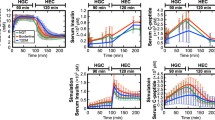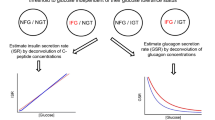Summary
Although it is generally accepted that islet amyloid polypeptide is cosecreted with insulin, relatively few data on its kinetics are available. We therefore studied the dynamics of islet amyloid polypeptide release following oral and frequently sampled intravenous glucose tolerance tests in comparison to insulin and C-peptide using mathematical model techniques in 14 control subjects, 10 obese and 11 hyper-tensive patients. The fractional clearance rate of islet amyloid polypeptide (0.034 ±0.004 min−1 in control subjects, 0.058 ± 0.008 in the obese and 0.050 ± 0.008 in the hypertensive patients) was significantly different (p < 0.01) in each group compared with that of insulin (0.14 ± 0.03 min−1) and similar to that of C-peptide (0.061 ± 0.007 min−1), at least in the insulin-resistant subjects. Based on the insulin sensitivity index derived from the minimal model analysis of intravenous glucose tolerance test data, both the hypertensive (2.4 ±0.4 min−1/(μU/ml); p < 0.0005) and the obese (2.7 ±0.5; p < 0.001) patients demonstrated severe insulin resistance compared to control subjects (8.1 ± 1.3). Marked insulin hypersecretion was found in the hypertensive (57.6 ± 5.2 nmol · 1−1 in 180 min; p < 0.001) and obese (60.8 ± 10.1; p < 0.003) patients in comparison with control subjects (32.4 ± 3.2). The release of islet amyloid polypeptide was significantly higher in the hypertensive (83.1 ± 16.6 pmol/1 in 180 min; p < 0.02) and obese (78.6 ± 13.1; p < 0.005) patients than in control subjects (40.5 ± 6.4). No correlation was found between islet amyloid polypeptide release and the insulin sensitivity index in any group. We conclude that, due to a significantly slower clearance of islet amyloid polypeptide in comparison to insulin, reliance on molar ratios between these two peptides might be misleading in the interpretation of islet amy-loid polypeptide secretion especially under non-steady-state conditions.
Similar content being viewed by others
References
Kahn S, D’Alessio DA, Schwartz MW et al. (1990) Evidence of cosecretion of islet amyloid polypeptide and insulin by B cells. Diabetes 39: 634–638
Sowa R, Sanke T, Hirayama J et al. (1990) Islet amyloid polypeptide amide causes peripheral insulin resistance in vivo in dogs. Diabetologia 33: 118–120
Huang HJS, Young AA, Koda JE, Tulp OL, Johnson MJ, Cooper GJS (1992) Hyperamylinemia, hyperinsulinemia, and insulin resistance in genetically obese LA/N-cp rats. Hypertension 19[Suppl I]: 101–109
Cooper GJS, Leighton B, Dimitriadis G et al. (1988) Amylin found in amyloid deposits in human type 2 diabetes mellitus may be a hormone that regulates glycogen metabolism in skeletal muscle. Proc Natl Acad Sci USA 85: 7763–7766
Molina JM, Cooper GJS, Leighton B, Olefsky JM (1992) Induction of insulin resistance in vivo by amylin and calcitonin gene related peptide. Diabetes 39: 260–265
Leighton B, Cooper GJS (1988) Pancreatic amylin and calcitonin gene related peptide cause resistance to insulin in skeletal muscle in vitro. Nature 335: 632–635
Koopmans SJ, van Mansfeld ADM, Jansz HS et al. (1991) Amylin induced in vivo insulin resistance in conscious rats: the liver is more sensitive to amylin than peripheral tissues. Diabetologia 34: 218–224
Frontoni S, Choi SB, Banduch D, Rossetti L (1991) In vivo insulin resistance induced by amylin primarily through inhibition of insulin stimulated glycogen synthesis in skeletal muscle. Diabetes 40: 568–573
Ohsawa H, Kanatsuka A, Yamaguchi T, Makino H, Yoshida S (1989) Islet amyloid polypeptide inhibits glucose-stimulated insulin secretion from isolated rat pancreatic islets. Biochem Biophys Res Commun 160: 961–967
Kassir AA, Upadhyay AK, Lim TJ, Moossa AR, Olefsky JM (1991) Lack of effect of islet amyloid polypeptide to cause insulin resistance in conscious dogs during euglycemic clamp studies. Diabetes 40: 998–1004
Ludvik B, Lell B, Hartter E, Schnack C, Prager R (1991) Decrease of stimulated amylin release precedes impairment of insulin secretion in type 2 diabetes. Diabetes 40: 1615–1619
Sanke T, Hanabusa T, Nakano Y et al. (1991) Plasma islet amyloid polypeptide (amylin) levels and their response to oral glucose in type 2 (non-insulin-dependent) diabetic patients. Diabetologia 34: 129–132
Johnson KH, O’Brien TD, Jordan K, Westermark P (1989) Impaired glucose tolerance is associated with increased islet amyloid polypeptide (IAPP) immunoreactivity in pancreatic beta cells. Am J Pathol 135: 245–250
Ludvik B, Clodi M, Kautzky-Willer A et al. (1993) Effect of dexamethasone on insulin sensitivity, islet amyloid polypeptide and insulin secretion in humans. Diabetologia 36: 84–87
Westermark P, Johnson KH, O’Brien TD, Betsholtz C (1992) Islet amyloid polypeptide — a novel controversy in diabetes research. Diabetologia 35: 297–303
Inoue K, Hisatomi A, Umeda F, Nawata H (1992) Relative hypersecretion of amylin to insulin from rat pancreas after neonatal STZ treatment. Diabetes 41: 723–727
Hartter E, Svoboda T, Ludvik B et al. (1991) Basal and stimulated plasma levels of pancreatic amylin indicate its cosecretion with insulin in humans. Diabetologia 34: 52–54
Hartter E, Svoboda T, Ludvik B et al. (1990) Reduced islet amyloid polypeptide in insulin dependent diabetes mellitus. Lancet I: 854
Pacini G, Bergman RN (1986) MINMOD: computer program to calculate insulin sensitivity and pancreatic responsivity from the frequently sampled intraveneous glucose tolerance test. Comp Meth Progr Biomed 23: 113–122
Bergman RN, Prager R, Volund A, Olefsky J (1987) Equivalence of the insulin sensitivity index in man derived by the minimal model method and the euglycemic glucose clamp. J Clin Invest 79: 790–800
Bergman RN, Phillips LS, Cobelli C (1981) Physiologic evaluation of factors controlling glucose tolerance in man. J Clin Invest 68: 1456–1467
Ferrannini E, Cobelli C (1987) The kinetics of insulin in man. Diabetes Metab Rev 3: 365–397
Polonsky KS, Rubenstein AH (1984) C-peptide as a measure of the secretion and hepatic extraction of insulin: pitfalls and limitations. Diabetes 33: 486–494
Carson ER, Cobelli C, Finkelstein L (1983) The mathematical modeling of metabolic and endocrine systems. Wiley, New York
Eaton RP, Allen RC, Shade DS, Erickson KM, Standefer J (1980) Prehepatic insulin production in man: kinetic analysis using peripheral connecting peptide behaviour. J Clin Endocrinol Metab 51: 520–528
Polonsky K, Licinio-Paixao J, Given BD et al. (1986) Use of biosynthetic human C-peptide in the measurement of insulin secretion rates in normal volunteers and type I diabetic patients. J Clin Invest 77: 98–105
Volund A, Polonsky KS, Bergman RN (1987) Calculated pattern of intraportal insulin appearance without independent assessment of C-peptide kinetics. Diabetes 36: 1195–1202
Cobelli C, Pacini G (1988) Insulin secretion and hepatic extraction in humans by minimal modeling of C-peptide and insulin kinetics. Diabetes 37: 223–231
Cobelli C, Thomaseth K (1988) On the optimality of the impulse input for linear system identification. Math Biosc 89: 127–133
Watanabe RM, Volund A, Roy S, Bergman RN (1989) Prehepatic β-cell secretion during the intravenous glucose tolerance test in humans: application of a combined model of insulin and C-peptide kinetics. J Clin Endocrinol Metab 69: 790–797
Kautzky-Willer A, Pacini G, Weissel M, Capek M, Ludvik B, Prager R (1993) Elevated hepatic insulin extraction in essential hypertension. Hypertension 21: 646–653
Kautzky-Willer A, Pacini G, Ludvik B, Schernthaner G, Prager R (1992) Beta-cell hypersecretion and not reduced hepatic insulin extraction is mainly responsible for hyper-insulinemia in obese nondiabetic subjects. Metabolism 41: 1304–1312
de Boor C (1978) A practical guide to splines. Springer Verlag, New York
Thomaseth K (1993) PANSYM: a symbolic equation generator for mathematical modelling, analysis and control of metabolic and pharmacokinetic systems. Comput Methods Programs Biomed (in press)
Fehmann HC, Weber V, Göke R, Göke B, Arnold R (1990) Cosecretion of amylin and insulin from isolated rat pancreas. FEBS Lett 262: 279–281
Kahn SE, Fujimoto WY, D’Alessio DA, Ensinck JW, Porte D (1991) Glucose stimulates and potentiates islet amyloid polypeptide secretion by the B-cell. Horm Metab Res 23: 577–580
Mitzukawa T, Takemura J, Asai J et al. (1990) Islet amyloid polypeptide response to glucose, insulin, and somatostatin analogue administration. Diabetes 39: 639–642
Inoue K, Hisatomi A, Umeda F, Nawata H (1992) Effects of exogenous somatostatin and insulin on islet amyloid polypeptide (amylin) release from perfused rat pancreas. Horm Metab Res 24: 251–253
O’Brien TD, Westermark P, Johnson KH (1991) Islet amy-loid polypeptide and insulin secretion from isolated perfused pancreas of fed, fasted, glucose-treated and dexamethasone-treated rats. Diabetes 40: 1701–1706
Stephens TW, Heath WF, Hermeling RN (1991) Presence of liver CGRP/amylin receptors in only nonparenchymal cells and absence of direct regulation of rat liver glucose metabolism by CGRP/amylin. Diabetes 40: 395–400
Roden M, Liener K, Fürnsinn C et al. (1992) Effects of islet amyloid polypeptide on hepatic insulin resistance and glucose production in the isolated perfused rat liver. Diabetologia 35: 116–120
Ludvik B, Berzlanovich A, Harrter E, Lell B, Prager R, Graf H (1990) Increased amylin levels in patients on chronic hemodialysis. Nephrol Dial Transplant 8: 694 A-695 A
Stokholm KH, Broechner-Mortensen J, Hoilund-Carlsen PF (1980) Increased glomerular filtration rate and adrenocortical function in obese women. Int J Obes 4: 57–63
Author information
Authors and Affiliations
Rights and permissions
About this article
Cite this article
Kautzky-Willer, A., Thomaseth, K., Pacini, G. et al. Role of islet amyloid polypeptide secretion in insulin-resistant humans. Diabetologia 37, 188–194 (1994). https://doi.org/10.1007/s001250050092
Received:
Revised:
Issue Date:
DOI: https://doi.org/10.1007/s001250050092




